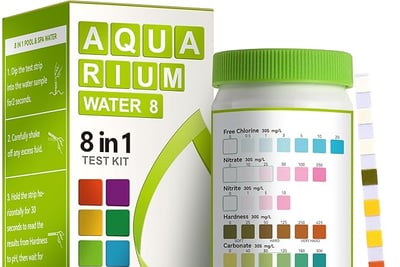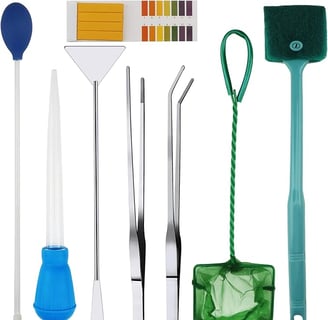A Complete Guide to Cycling Your Fish Tank
8 min read


Understanding the Nitrogen Cycle
The nitrogen cycle is a fundamental biological process that ensures the health and stability of a fish tank. It involves the transformation of toxic substances generated from fish waste, uneaten food, and organic debris into less harmful compounds that can be easily managed within the aquatic environment. Central to this process are beneficial bacteria that play a vital role in promoting a safe habitat for your aquatic friends.
Initially, when fish excrete waste or organic material decomposes, ammonia is released into the water. Ammonia is highly toxic to fish, and if not managed properly, can lead to severe health issues or even fatalities. Fortunately, nitrifying bacteria present in the substrate and filter media actively convert ammonia into nitrites through a process known as nitrification. This initial step is crucial, as nitrites, while less harmful than ammonia, still pose risks to fish health if allowed to accumulate.
As the nitrogen cycle progresses, another group of bacteria further steps in to convert nitrites into nitrates. This second stage of the process is equally important; while nitrates are significantly less toxic, they can still affect the fish in high concentrations. Regular water changes are essential for maintaining optimal nitrate levels and ensuring a healthy aquatic environment.
The establishment of a balanced nitrogen cycle requires time and patience, as beneficial bacteria need to proliferate to effectively manage waste. This is why cycling a fish tank is recommended before introducing fish, allowing these bacteria to establish themselves. Additionally, keeping your filtration system clean and your tank properly stocked will help maintain this delicate ecosystem. Understanding and nurturing the nitrogen cycle is crucial for all aquarium owners seeking to provide a safe and vibrant home for their fish.
Why Cycling Is Crucial for Your Fish Tank
Cycling a fish tank is an essential process that establishes a stable and healthy environment for aquatic life. The cycling process involves the establishment of beneficial bacteria responsible for converting harmful ammonia produced by fish waste into less toxic substances. When an uncycled tank is set up, the levels of ammonia can rapidly increase, leading to ammonia poisoning. This toxic condition can be detrimental to fish health, causing stress and, in extreme cases, death.
When introducing fish into an uncycled tank, the stress levels can be significantly heightened. Fish are highly sensitive to changes in their environment, and toxic spikes can lead to a weakened immune system, making them more susceptible to diseases. The lack of adequate biological filtration also leads to erratic water quality, further aggravating the situation for the fish. Therefore, cycling your tank is crucial not only for the well-being of your aquatic pets but also for the overall stability of the ecosystem.
Conversely, a well-cycled fish tank provides multiple benefits. The establishment of beneficial bacteria helps maintain safe levels of ammonia and nitrite, fostering a healthier environment for fish. This balanced ecosystem contributes to reduced stress levels among aquatic inhabitants, allowing them to thrive. Additionally, a properly cycled tank often leads to clearer water, making it more aesthetically pleasing for the aquarist and visitors alike. Ultimately, successful cycling serves as a foundation for a thriving aquatic habitat, minimizing potential health crises while maximizing enjoyment for both fish and their caretakers.
Different Methods of Cycling a Fish Tank
Cycling a fish tank is an essential process for establishing a stable and healthy aquatic environment. This can be achieved through various methods, each with its unique advantages and challenges. Three commonly used methods are fish-in cycling, fishless cycling, and using live plants to initiate the cycling process.
The fish-in cycling method involves introducing fish into the newly set-up tank while simultaneously developing beneficial bacteria. This approach allows the bacteria to establish while the fish produce waste, which in turn fuels their growth. However, this method carries several risks, including potential stress and harm to the fish due to poor water quality during the cycling period. It is crucial to monitor ammonia and nitrite levels closely, as elevated concentrations can be lethal to fish.
On the other hand, the fishless cycling method is considered safer for aquatic inhabitants. In this approach, ammonia is added to the tank artificially, creating the ideal environment for beneficial bacteria to thrive. This method typically takes anywhere from a few weeks to a couple of months, but it ensures that the tank is fully cycled before introducing any fish. While it may require some patience and consistent monitoring of ammonia and nitrite levels, this approach minimizes the risk of harming fish during the cycling phase.
Another effective method involves utilizing live plants to assist in cycling the tank. Live plants naturally absorb ammonia and nitrates, which can support the growth of beneficial bacteria. This method often results in a more visually appealing aquarium setup and can improve water quality while providing additional oxygen. However, it is essential to choose suitable plants that thrive in the specific conditions of your tank, including lighting and water parameters.
In summary, each cycling method presents its benefits and drawbacks. By understanding these various approaches, aquarists can select the most appropriate method for their unique circumstances, ensuring a safe and healthy habitat for their aquatic friends.
Setting Up Your Tank for Cycling
Establishing a fish tank is a crucial step in the cycling process, which aims to create a stable and healthy aquatic environment. The first consideration is selecting the appropriate equipment, notably the filter, heater, and lighting. An efficient filter is essential for aeration and mechanical cleaning, while a heater is important for maintaining optimal water temperatures, particularly for tropical fish. In terms of lighting, choose a system that promotes plant growth if live plants are included in the setup.
Next, focus on the substrate. Gravel, sand, and specially formulated substrates all serve as excellent bases for your tank. When selecting a substrate, consider the needs of your chosen fish species and any plants you plan to include. Additionally, the substrate can aid in the development of beneficial bacteria that are vital for biological filtration during the cycling phase.
Decorations, including rocks, driftwood, and artificial plants, contribute to both aesthetics and functionality. They provide hiding spots and surfaces for beneficial bacteria to colonize. Ensure that any materials used are aquarium-safe and free from harmful chemicals. Once the substrate and decorations are in place, carefully fill the tank with water, taking care to avoid disturbing the substrate. It is recommended to use a water conditioner to remove chlorine, chloramines, and harmful heavy metals present in tap water.
Before introducing any fish, it is essential to test the water parameters, including pH, ammonia, nitrite, and nitrate levels, to ensure they are within safe ranges for the species you plan to keep. A well-set tank will provide the ideal environment for beneficial bacteria to thrive, laying the groundwork for a successful cycling process. By meticulously preparing your tank, you can establish a healthy ecosystem conducive to the well-being of your aquatic friends.
Monitoring Water Parameters During Cycling
Monitoring water parameters is a crucial aspect of cycling your fish tank, ensuring that it becomes a safe and healthy environment for your aquatic friends. During the cycling process, your primary focus should be on three main substances: ammonia, nitrites, and nitrates. Each of these compounds plays a significant role in the nitrogen cycle, which is essential for establishing a balanced aquarium ecosystem.
To accurately monitor these levels, it is recommended to invest in high-quality water testing kits. These kits typically include reagents for testing ammonia, nitrites, and nitrates, allowing you to assess the water conditions in your tank. Regular testing, ideally every few days, will help you track the progress of your tank’s cycling process. The initial phase usually involves rising ammonia levels, which should peak before dropping as beneficial bacteria establish themselves, converting ammonia to nitrite. During this time, you should expect nitrite levels to rise until they too start to diminish.
As the cycling progresses, the subsequent buildup of nitrates signifies that your fish tank is nearing completion of the nitrogen cycle. The ideal levels for these parameters are typically as follows: ammonia should remain at 0 ppm, nitrites should also be at 0 ppm, while nitrates can range from 5 to 20 ppm for a newly cycled tank. Monitoring these values is vital; if ammonia or nitrite levels exceed acceptable limits, it is advisable to perform partial water changes to maintain a suitable environment for fish.
By understanding how to interpret these testing results, you will be able to determine when your tank is fully cycled and ready to introduce your fish. This careful observation and timely intervention ensure that your aquatic friends enter a stress-free and thriving habitat, contributing to their long-term health and well-being.
Transitioning Fish into the Cycled Tank
Once the nitrogen cycle in your fish tank has been established, the next crucial step is to smoothly transition your aquatic friends into their new environment. Careful acclimatization is essential to minimize stress and ensure the well-being of your fish. The process usually involves several stages, each designed to introduce the fish gradually to the cycled tank conditions.
Start by placing the sealed bag containing your fish into the tank where they will reside. This method allows the water temperature within the bag to equilibrate with that of the fish tank, preventing thermal shock. After about 15 to 20 minutes, open the bag and gradually mix water from the tank into the bag. This step is vital, as it familiarizes the fish with the chemistry of their new home, including parameters like pH and hardness. Continue adding small amounts of tank water to the bag over the next 30 to 60 minutes, gradually increasing the proportion of tank water.
When it comes time to introduce the fish into the cycled tank, carefully net them out instead of pouring them directly from the bag. This method avoids introducing any uneaten food or waste from the bag that could disrupt the delicate balance within your tank. Once the fish are in their new habitat, observe their behavior closely for the first few hours. Signs of stress such as heavy breathing, unusual hiding, or disorientation should be monitored, and if exhibited, it's advisable to reconsider water conditions or the acclimatization process.
Additionally, it is crucial to introduce only a few fish at a time, avoiding overstocking which can lead to poor water quality. Allow your tank to adjust to the bio-load each time you add new occupants. This cautious, gradual approach to transitioning your fish into their cycled tank will promote a healthier environment, ultimately ensuring a longevity of both your aquatic friends and the ecosystem you have created.
Maintaining Your Fish Tank After Cycling
Once the cycling process of your fish tank has been successfully completed, ongoing maintenance is crucial to support the health of your aquatic inhabitants. Regular water changes play a significant role in maintaining a stable environment. It is recommended to perform partial water changes, approximately 10-15% of the tank volume, weekly. This practice helps to dilute any accumulated toxins, nitrates, and other harmful substances, thereby promoting a healthier habitat for your fish.
Cleaning the aquarium is another vital aspect of post-cycling maintenance. However, it is important to approach cleaning with care. Use an aquarium-safe algae scraper or sponge to remove any visible algae on the tank walls, ensuring not to disturb beneficial bacteria residing on surfaces like substrate and decorations. Furthermore, when cleaning the filter, it is advisable to rinse the filter media in water siphoned from the tank rather than tap water. This practice preserves the essential beneficial bacteria that contribute to the nitrogen cycle.
Monitoring water parameters is essential for sustaining a thriving fish environment. Regularly test the pH, ammonia, nitrite, and nitrate levels to ensure they remain within appropriate ranges for the species you keep. Investing in quality test kits can provide accurate readings, allowing any necessary adjustments to be made promptly. Additionally, maintaining these beneficial bacteria populations is critical. Avoid introducing harsh chemicals or medications that may disrupt the established biological filter. Instead, consider using products specifically designed to promote or replenish beneficial bacteria when needed.
Lastly, observe your fish regularly for signs of stress or illness. A proactive approach can help identify problems before they escalate. Providing appropriate food, maintaining stable water conditions, and monitoring for aggressive behaviors will ensure a long-lasting, healthy environment for your aquatic friends. By implementing these ongoing maintenance practices, you help secure the well-being of your fish tank long after the cycling process has concluded.











